Introduction to Trading Styles, Psychology and Strategies in Forex Trading
Picking the right and best forex strategy is crucial for successful and comfortable trading. By comfortable, I mean that the trading strategy you choose has to accommodate your personal trading style, your preferences, mindset and available time to trade the markets. There is a big difference between traders who look for fast-paced trading opportunities, sitting in front of the screen for hours a day, and traders who prefer to take a position based on fundamental triggers and hold it for weeks or months to come. Naturally, these two groups of traders can’t employ the same trading strategy, as the timeframe and entry and exit signals, to name a few, vary greatly among them.
There is also the psychological factor that adds to the necessity of choosing a forex trading strategy that suits best to your psychological profile. Are you calm in periods of high price volatility, and do you keep a cool head when the price turns against you for a few hours or even days? Do you prefer to take a smaller amount of highly profitable trades, or a larger number of small winners? Of course, the psychological factor in trading is one of the most important aspects that differentiate successful from unsuccessful traders, and will also be covered in this detailed guide.
If your current trading strategy doesn’t suit your trading profile, or you feel uncomfortable in utilizing it during different market environments, then there is a high probability that you picked the wrong trading strategy for you. We’ll cover various trading styles, their characteristics and trading strategies, so you can perform a due-diligence of your current state in trading and see how you can pick the best forex strategy for yourself. The first step is to identify which trading style suits you best, based on your available time for trading, risk profile, preferred method of market analyzing (fundamental vs. technical) and psychological traits.
After each trading style I’ll show you an example of the most popular trading strategy for that style, so you can make notes along the way and see what style and strategy you’re most comfortable with. Remember that the first step in becoming a profitable trader is knowing your strengths and weaknesses, and picking a trading style and strategy that takes advantage of your pros, and neutralizes or minimizes your cons. So, let’s get started!
Scalping – The Fast-Paced Forex Trading Style
The first trading style that we’ll cover is scalping. You’ve probably already heard about scalpers – those are the traders whose trading strategy is based on scalping. Scalping is a fast-paced trading style that isn’t suited for all traders. Scalpers trade on very short time-frames, such as the 1-minute, 5-minute or 15-minute time-frames, and hold their trades for a very short period of time. They aim for very small gains, sometimes as low as a few pips, and get out of the trade as soon as they reach their profit target. It’s not unusual to close a trade only a few seconds after it was opened, which means that scalpers prefer forex brokers that offer very tight spreads as they take a large number of trades during the day.
Traders who choose a scalping trading style need to be able to spend hours in front of the screen, which means that if you have a day job, this is probably not the right trading approach for you. In addition, scalpers need to be comfortable with accepting many small losses along the way, but they know that in the end of the day, their overall winnings shall exceed their losses.
-
How a Typical Scalping Trading Strategy Looks Like
Scalpers often use mechanical strategies in their trading, which means that signals from technical indicators are often used to trigger the entry into a trade. An example of a scalping trading strategy is shown below, based on trading overbought and oversold market conditions on the 1-minute timeframe.

The RSI (Relative Strength Index), with a short setting of 7-periods, is used to provide fast trade signals on a short timeframe like the 1-minute one. As you can see, a scalper would look for overbought levels of the indicator (above 70) to enter with a short position, and for oversold levels (below 30) to enter with a long position. By taking a large number of trades, scalpers can still make a profit despite the small number of pips they make per each trade.
Day Trading – A Popular Way to Trade Forex
Day trading is a very popular trading style in the forex market. Day traders hold their positions only throughout the day, and close them by the end of the trading day. They usually pick a direction of the market in the early morning, based on news or technical analysis, and spend less time in front of the screen compared to scalpers. Day traders do manage their trades over the day, to make sure that the market sentiment hasn’t changed since they entered the market. The typical timeframes that day traders use are the 15-minutes, 30-minutes and 1-hours timeframes, and the number of trades they take can vary from one to a few during the day.
Day trading is typically less stressful than scalping. This kind of traders check the forex calendar and charts first thing in the morning, to get a feeling of what the market did in the previous trading session. Their trades, being held longer, return higher profits in case the analysis was correct, which means that day traders have the ability to take a smaller number of trades than scalpers but still generate a respectable profit. Day traders also care less about trading fees and spreads than scalpers, and can take a free time once they do their analysis and open their trades for the day. Day traders also have clear stop-loss and take-profit levels for their trades, which save their capital in case of unexpected news and market events throughout the day. If you feel attracted to the characteristics of day trading, then the following lines may uncover the best forex strategy for you.
Day traders can be further grouped into three main groups according to the trading strategy they employ: trend traders, countertrend traders, and breakout traders.
-
Day Trading Strategy: Trend Trading
Trend trading is a type of day trading that focuses on riding the intraday trend of a currency pair. Trend traders look for higher highs and higher lows during uptrends, and lower lows and lower highs during downtrends. The majority of their trading decisions are based on technical tools such as trendlines and support & resistance levels, and they only take trades that align with the bigger picture and overall trend of the pair.
The advantage of this strategy is that it opens only trades in the direction of the trend, hence the name “trend trading”. This returns high-probability trading setups with clear entry and exit targets, but can also occasionally return losses in times of a heavy market correction. Fortunately, with the use of technical trading rules, trend traders can spot possible corrections in advance, by the breakout of a trendline, failure and non-failure swings and the inability of the price to make fresh higher highs or lower lows. The following chart shows an intraday trend trading setup.
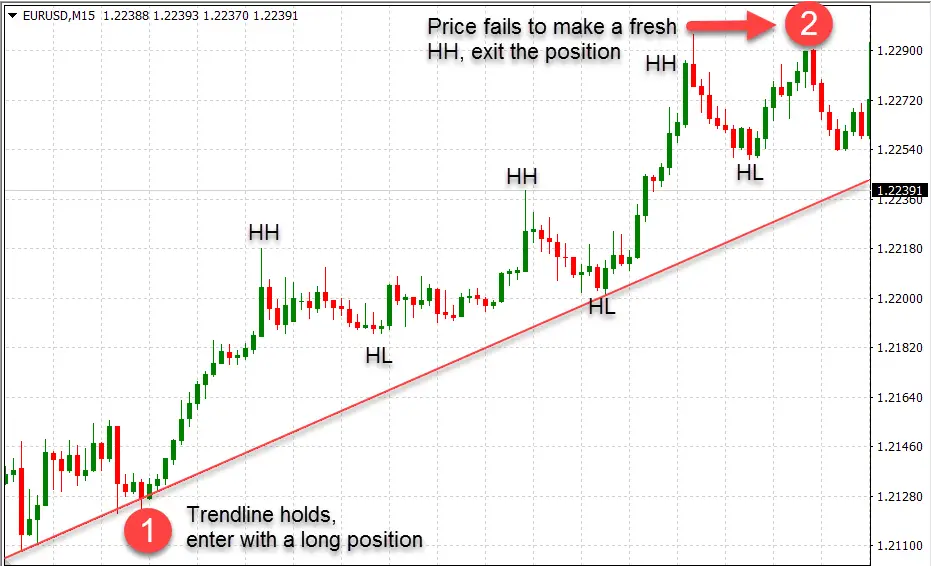
At point (1), the intraday trendline showed to hold which created a buy opportunity in the direction of the trend. The price made consecutive higher highs and higher lows, which are characteristics of uptrends, and the long position remained active until the price failed to make a fresh higher high, or until the end of the trading day.
-
Day Trading Strategy: Countertrend Trading
Countertrend trading is very similar to the trend trading strategy, only that it focuses on corrections of the price that go against the overall trend. In other words, countertrend traders look for corrections and take trades in the opposite direction of the greater trend. They often use Fibonacci retracement levels to identify zones to which the price is going to retrace. While countertrend trading can be profitable with the right analysis, it can also generate losses if traded the wrong way. Generally, countertrend trading is riskier than trend trading, as you need to find the correct level at which the price is going to make a correction and enter it. As this is also a day trading strategy, countertrend traders usually hold their trades intraday and close all open positions by the end of the trading day. Let’s take a look at how a countertrend entry in the market looks like.
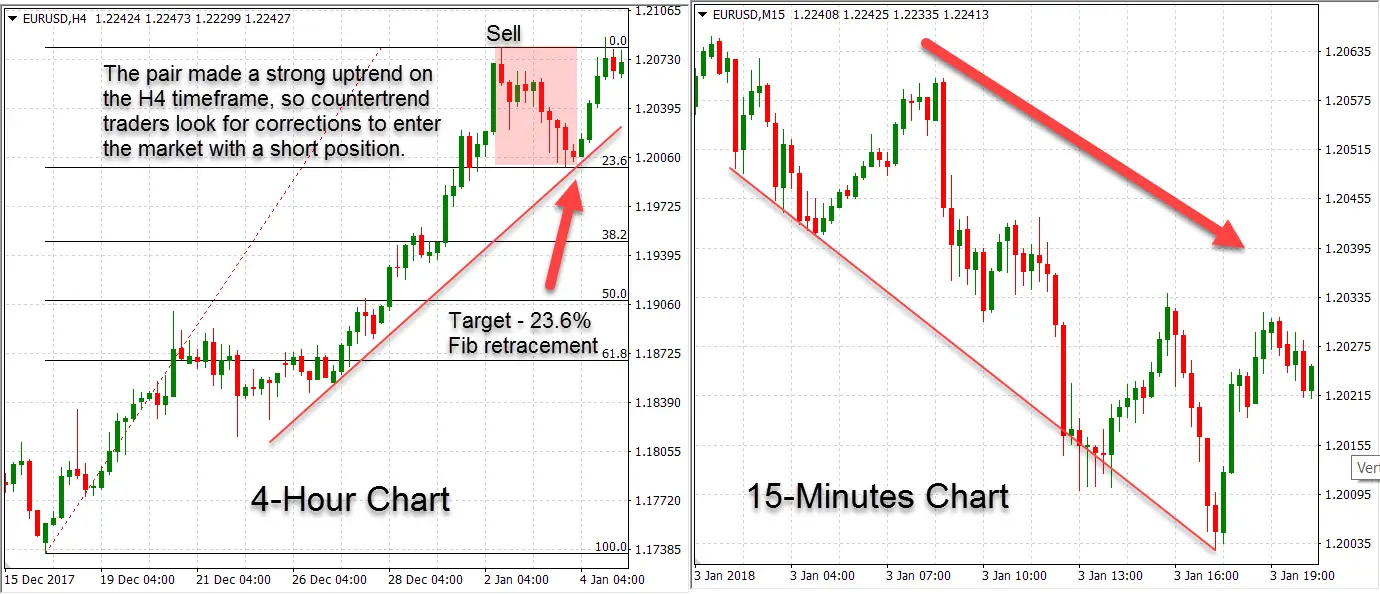
The 4-hour chart shows a strong uptrend on the EUR/USD pair, but countertrend traders look for corrections against the overall trend. The Fibonacci retracement of 23.6% is used to identify the profit target, and on the 15-minutes intraday chart a fall in price is easily recognizable.
-
Day Trading Strategy: Breakout Trading
The third type of day trading is breakout trading. As its name suggests, breakout trading is based on breakouts out of important price zones, such as support and resistance lines, chart patterns or channels. A breakout out of those zones creates a strong momentum in the direction of the breakout, and breakout traders try to take advantage of that. Again, as this is also a day trading strategy, trades are held throughout the day and closed by the end of the trading day. The following chart shows a typical breakout trade based on the 15-minutes chart.
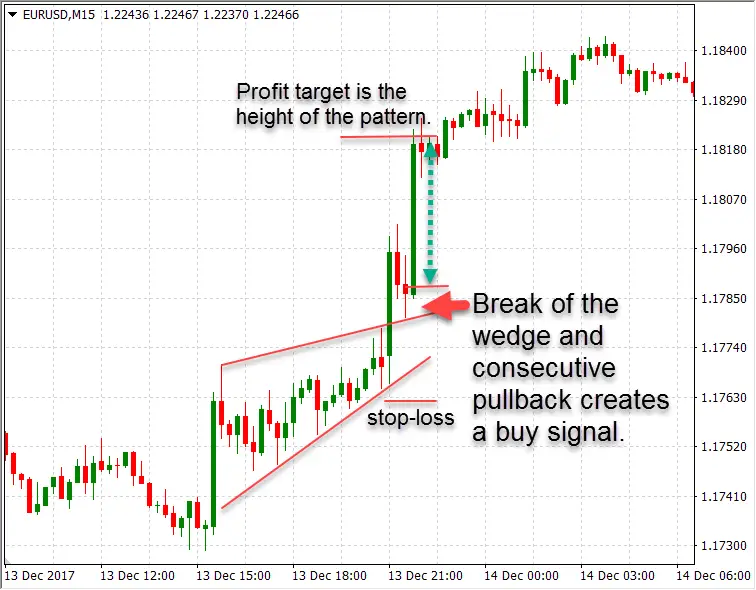
The trade above shows a breakout out of the wedge pattern, and the pullback adds to the significance of the pattern. Breakout traders would look for signals like this to enter the trade, with a stop-loss just below the pattern, and a profit target at a distance that equals the height of the wedge pattern.
Swing Trading – Holding Your Trades Overnight
The next trading style and strategy that we’ll cover is swing trading. Swing trading aims to identify swing points and to trade the consecutive price moves. This includes swing highs and swing lows which can last up to a few days or even more. As with day traders, swing traders are therefore less affected by spreads than scalpers, and they aim to take a smaller number of highly profitable trades that can achieve even hundreds of pips in some cases.
Swing traders require less screen time than their scalping and day trading peers, which makes swing trading a good choice for traders who aren’t able to follow the market every day. However, as a swing trader, you’ll still need to manage your open positions, but this can be done on a less regular basis than day traders do, because swing trades are open for a longer period of time. This requires swing traders to be more patient than day traders, and they also have to remain calm when the price goes against them during the holding period. Wider stop-losses are also a must to accommodate for the larger price fluctuations on longer timeframes. If you like fast-paced action and don’t have the patience to hold trades for days to make a profit, you should think about scalping or day trading instead as swing trading may not include the best forex strategy for you.
-
Swing Trading Strategy
Trading swing highs and swing lows can be based on a variety of trading tools, such as channels, support & resistance lines, chart patterns and so on, and the key to be a successful swing trader is to be able to spot the swing highs and lows at their peak levels. Let’s take a look at a swing trade:
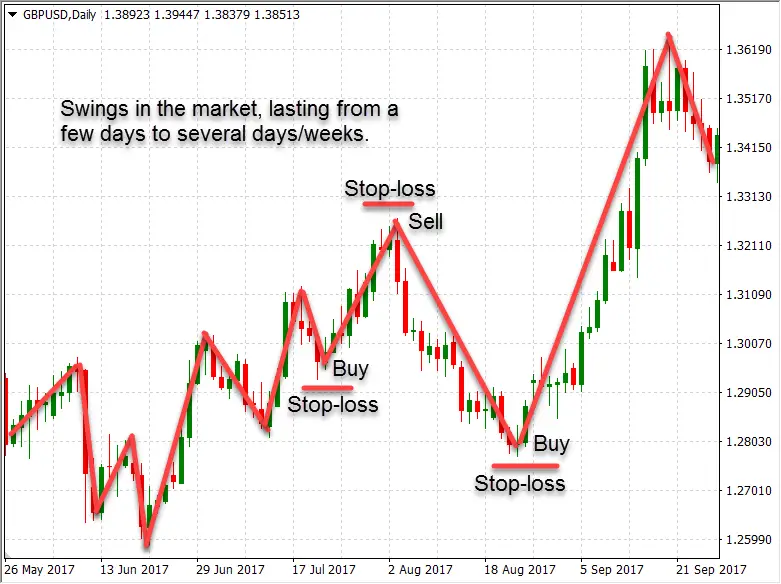
As the chart above shows, the market is constantly making swing highs and swing lows, shown by the red lines on the chart. Being a longer-term trading style than scalping and day trading, many of the swings have a fundamental reason behind the move. This is why swing traders need to be up-to-date with the fundamental side of the market as well. Stop-loss orders are usually put just below the recent swing low, or just above the recent swing high.
Position Trading – The Way Professional Traders Trade
Position traders are a special breed of traders. They hold their trades for months or even years, and their grand reward is often in the thousands-of-pips range. Many professional traders at investment banks and hedge funds are position traders, and they consider all intraday price-action as “market noise” that can’t be traded upon. That being said, position traders largely base their trading decisions on fundamental factors, and they need to have a good understanding of various currency valuation models such as the PPP model (purchasing power parity), Balance of Payments model, Interest Rate model, Monetary model and other models that seek to identify the intrinsic value of a currency and its corresponding equilibrium exchange rate. Exchange rates are known to deviate to a large extent from their equilibrium level, but over the long-term they show the tendency of returning to their equilibrium level. That’s why position traders need to hold their trades for months or years, in order to fully exploit their fundamental trading analysis.
It your first thought was that position traders need to be extremely patient, you’re fully correct. Holding trades for so long not only requires patience, but also a large sum of capital to withstand any negative price fluctuations along the way. This means that stop-losses are placed hundreds of pips away from the entry price, and position traders don’t get nervous if the trade goes against them in some point of the future. Also, letting profits run is very important, and if you already get excited when you’re 100 pips in profit, you should look for a shorter-term trading style discussed in this article.
In addition, position traders need to be independent thinkers and not be carried away buy the mainstream opinion. All this requires good knowledge of fundamental factors and asks for years of experience in the markets. Position traders are usually 80% fundamental, and 20% technical traders.
Mechanical Trading – Automated Trading Based on Technical Indicators
Mechanical traders are traders who base their trading decisions solely on technical tools – mostly on technical indicators such as the RSI, MACD and moving averages, to name a few. Their entry points are strictly predetermined by the trading signals of their indicators, and mechanical traders have the ability to convert their trading strategy into an automated trading robot (i.e. “Expert Advisor” on the MetaTrader platform). However, most technical indicators are lagging behind the price, and many times they may create false signals that lead to losing trades. But, if mechanical traders develop a trading edge with their strategy, over a large enough number of trades they can end up profitable.
-
Mechanical Trading Strategy
A typical mechanical trading strategy is based on one or more indicators, which combined generate the entry signals. For example, a mechanical trader may use a Stochastics indicator to identify overbought and oversold levels of the market, and two moving averages of different speeds that generate trading signals based on a crossover strategy.
The mechanical system may wait for both the Stochastics becoming oversold, and the 10-MA crossing above the 50-MA to enter with a buy order. Similarly, an overbought Stochastics combined with a crossover of the 10-MA below the 50-MA may be used to generate a sell signal.
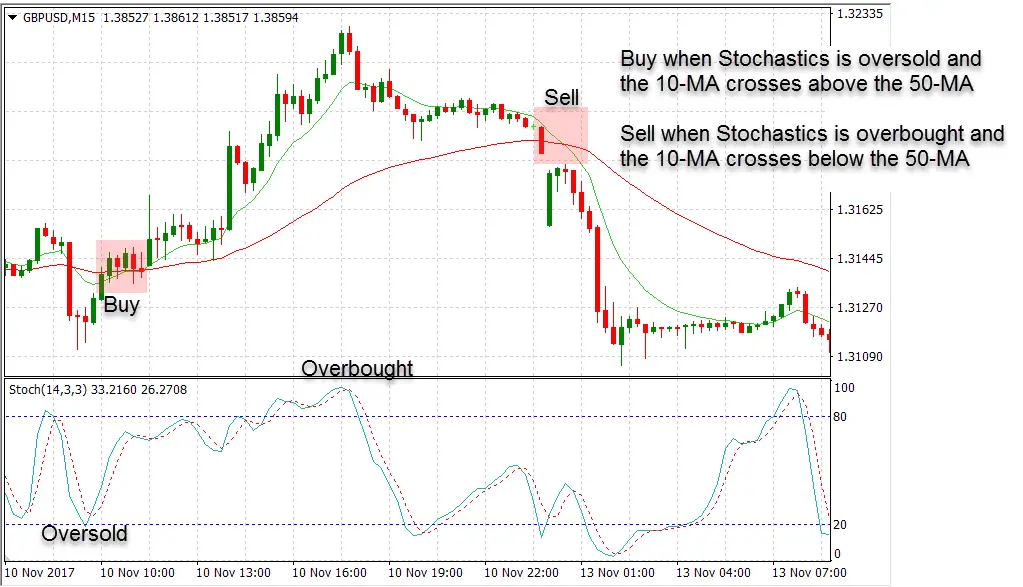
Which Trading Style Suits You Best?
If you’ve read carefully through this article, you should know by now what trading style and what corresponding strategy suits you best. The key is to analyze your own preferences, available time for trading and market expectations. Are you able to sit in front of your computer for hours to make many small winning trades, or do you prefer to day and swing trade the market a few times per week? Or maybe you’re attracted to mechanical trading, where the indicators do the most work for you and you just need to buy or sell based on their inputs. Whatever it is, make sure to know all the advantages and disadvantages of the mentioned trading styles, as well as of short-term trading, long-term trading and intraday trading.
If you still can’t make up your mind whether short-term or long-term trading is better for you, I wrote the main advantages and disadvantages of them into the table below.
|
TIME FRAME |
DESCIPTION | ADVANTAGES | DISADVANTAGES |
|
LONG-TERM |
|
|
|
|
SHORT-TERM (SWING) |
|
|
|
|
INTRADAY |
|
|
|
Conclusion
This article had the objective to introduce the main trading styles and their corresponding trading strategies to you. If you feel like your current forex trading strategy is not the best, and you feel that it doesn’t take advantage of your personal strengths (like patience, for example), you should have a clearer mind after this article showed which trading style and strategy suits your psychological side the best, and how to choose the best forex strategy for yourself.
The main trading styles discussed in this article – scalping, day trading, swing trading, position trading and mechanical trading – as well as the different forms of day trading (trend trading, countertrend trading and breakout trading), all have their own strengths and weaknesses. You, as a trader, need to match your strengths with the strengths of the trading style, and your weaknesses with the weaknesses of the trading style. If you’re an extremely impatient person, don’t fall into the trap of taking a position trader’s mindset – and similarly, if you like holding your trades for a few days and don’t have time to stick to your platform for hours per day, swing trading may be the best for you.
Also take into account the transaction costs associated with each trading style. Scalpers need brokers with very tight spreads, as they can make dozens of trades per day, while the other trading styles don’t have such problems. Day trading is a very popular forex trading style, but you still have to take your time to analyze the market and manage your positions. Swing trading suits those traders who look for higher profits out of a smaller number of trades, and can easily be combined with a day job. But, both swing traders and position traders should have a good understanding of fundamental factors in the forex market, which requires learning and experience to get there. Whatever trading style and strategy you choose, stick to it for a reasonable time period to get a feeling of how it suits your overall personal traits.
